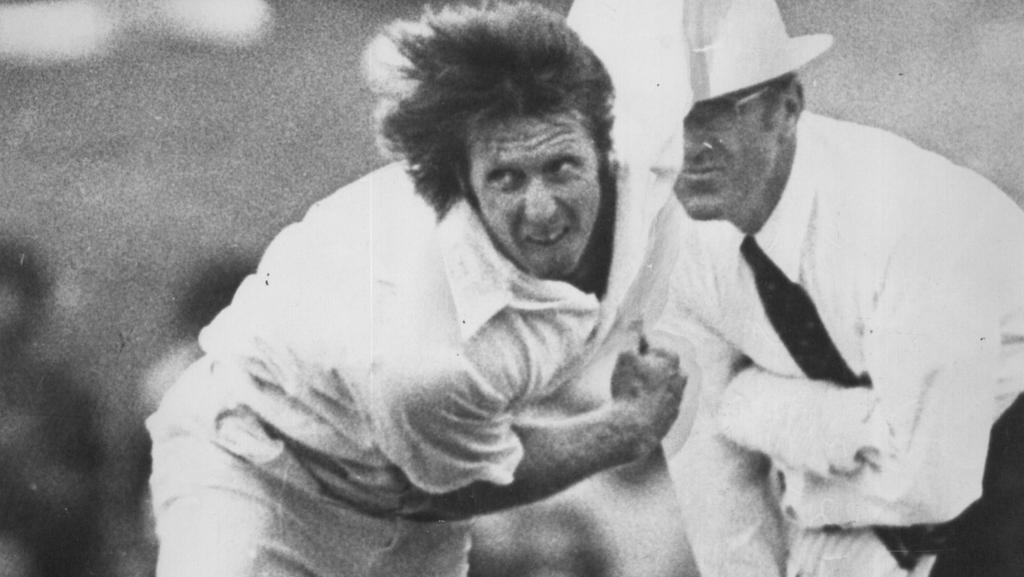In the 1970s and early 80s, Jeff Thomson unleashed blistering pace spells that terrorized global batting lineups and transformed perceptions of fast bowling limits.
While raw radar gun speeds drew awe, ‘Thommo’ channeled his gifts strategically, unlocking potency through shrewd aim, aesthetic fluidity and cunning changes of angle.
Statistical archives overflow with evidence of his menace claiming 200 Test wickets in just 51 matches. Yet Thomson’s spells resonated deeper through their growing mythos.
Blinding pace was weaponized by crowning peaks of bowling sorcery – yorkers crashing into toes or searing bouncers rebounding off shoulders. Amid the carnage flashed vibrant character, his moustache adding charisma.
Article Highlights
Hide- Jeff Thomson was born on August 16, 1950, in Sydney, Australia, and developed an interest in cricket at a young age.
- He rose to prominence as a fast bowler, impressing with his raw pace and aggression, and was selected for the Australian national team in 1972.
- Thomson played 51 Test matches for Australia, taking 200 Test wickets at an average of 28.00, and played a crucial role in Australia's victory in the 1975 World Cup.
- He revolutionized fast bowling with his sheer speed, inspiring a generation of fast bowlers around the world, and holds the record for the fastest recorded delivery in cricket history.
But behind headline exploits lay nuanced craft and grit endowing longevity too. Thomson overcame career-threatening injuries through resilience and technical evolution from slinging youth to master deploying angles, thrift and guile in elder years.
Both bruising speed merchant and wily wizard, Jeff Thomson lit afterburners under cricket’s imagination – his legacy scattered across shattered wickets and ignited passions.
Early Life and Upbringing
Jeff Thomson, one of cricket’s most fearsome fast bowlers, was born on August 16, 1950, in Greenacre, a suburb of Sydney, Australia.
He was raised in a working-class family that valued hard work and perseverance. Thomson’s upbringing in this gritty, industrious environment undoubtedly played a role in shaping his robust character and relentless drive—qualities that would later define his cricketing career.
Ray Lindwall
In post-World War II cricket, Ray Lindwall sculpted the template for Australian pace bowling ... Read More
From an analytical perspective, the environment of Thomson’s early life is noteworthy for its potential influence on his development as an athlete.
The values instilled from a young age—tenacity, resilience, and a no-nonsense attitude towards challenge—can be correlated with the mental fortitude required for success in the highly competitive arena of international cricket.
His formative years, therefore, were not merely a backdrop but a foundational period that sculpted the mental and physical capabilities necessary for his future endeavors on the cricket pitch.
The socio-economic context of Thomson’s upbringing also warrants attention. In an era where formal training and resources for aspiring athletes were not as accessible as they are today, Thomson’s emergence as a cricketing talent suggests a remarkable level of self-motivation and a natural aptitude for the sport.
This self-driven approach to honing his skills would later manifest in his distinctive, unorthodox bowling technique, which became a hallmark of his playing style.
Jeff Thomson: Rise to Cricketing Stardom
The ascent of Thomson to cricketing stardom commenced with his debut for Queensland in the 1972–73 season, where his raw pace and unconventional style swiftly captured the attention of the Australian cricketing fraternity.
His ability to bowl at extraordinary speeds, consistently surpassing the 90 miles per hour mark, made him an outlier in the fast bowling domain.
Thomson’s delivery, characterized by a slinging action, not only confounded batsmen but also redefined the paradigms of fear and intimidation on the cricket pitch.
Thomson’s rise was not merely a product of his physical attributes; it was also a testament to his psychological acumen. He possessed an uncanny knack for unsettling batsmen, exploiting their technical frailties and mental insecurities.
His partnership with fellow fast bowler Dennis Lillee, often referred to as the most fearsome bowling duo in Test cricket history, significantly amplified his impact.
This potent combination of physical prowess and mental sagacity propelled Thomson to international prominence during the 1974-75 Ashes series against England, where he claimed 33 wickets at a staggering average of 17.93, cementing his status as a cricketing luminary.
Notable Career Highlights
Among the zeniths of Thomson’s career was his remarkable performance in the 1974-75 Ashes series, where he dominated the English batting lineup with his ferocious pace and precision.
His relentless aggression and ability to generate express speeds made him an integral component of Australia’s bowling attack, culminating in a series that etched his name among cricketing legends.
To encapsulate the highlights of Thomson’s illustrious career, consider the following key achievements:
- 1974-75 Ashes Series: Thomson captured 33 wickets at an average of 17.93, with an economy rate that underscored his efficiency and potency as a fast bowler.
- Fastest Delivery: Clocked at a speed of 160.6 km/h during a study in 1976, Thomson was unofficially recognized as the fastest bowler of his time, a testament to his extraordinary bowling prowess.
- Career Wicket Tally: Accumulating 200 Test wickets in just 51 matches, his strike rate reflects a bowler of high impact, capable of turning matches with individual spells.
- Fear Factor: Thomson’s reputation for inducing fear in batsmen was not merely anecdotal; his aggressive style and raw speed significantly contributed to reshaping the psychology of pace bowling in the era.
Analyzing these achievements objectively, it becomes evident that Jeff Thomson’s career was characterized by a combination of raw speed, technical skill, and psychological dominance over opponents.
Jeff Thomson: Legendary Bowling Partnerships
Building on his individual accolades, Thomson’s legacy is further magnified by his formidable bowling partnerships, most notably with fellow Australian paceman Dennis Lillee, creating a tandem that struck terror in the hearts of batsmen worldwide.
Their synergy was not merely due to their pace; it was a blend of Lillee’s precision and Thomson’s raw speed that dismantled batting line-ups.
This partnership’s impact on games was quantifiable, with a significant number of wickets falling to their combined efforts, often setting the stage for Australian victories.
The statistical gravitas of Thomson’s partnerships can be seen in the table below, which contrasts the success of the Thomson-Lillee duo with Thomson’s performance alongside other bowlers.
| Partner | Wickets Together | Impact on Matches |
|---|---|---|
| Dennis Lillee | High | Decisive, often leading to Australian wins |
| Max Walker | Moderate | Complementary, but less dominant |
| Other Bowlers | Variable | Dependent on match context and conditions |
An analytical look at the figures reveals that while Thomson was a fierce competitor in his own right, it was his collaboration with Lillee that elevated their threat level exponentially.
Their combined approach to bowling was a strategic asset, with Thomson’s ferocious pace serving as the perfect foil to Lillee’s tactical nous.
Statistical Legacy
Delving into the statistical contributions of Jeff Thomson’s career, one discovers a record that encapsulates both his individual brilliance and his synergistic dominance within bowling partnerships.
Thomson’s statistical legacy is marked by the following achievements:
- Test Wickets: Thomson captured 200 wickets in 51 Test matches, boasting a remarkable average of 28.00, which is a testament to his ability to consistently dismiss batsmen at the highest level.
- Best Bowling Figures: His best bowling figures in an innings stand at 6/46, demonstrating his capacity to decimate opposition batting line-ups in single spells.
- Strike Rate: With a Test career strike rate of 56.7, Thomson was a bowler who could deliver wickets at regular intervals, maintaining pressure on the opposition.
- Partnership with Dennis Lillee: In conjunction with Dennis Lillee, Thomson formed a lethal partnership that accounted for numerous match-winning performances, their combined fear-inducing pace often turning the tide of matches.
These statistics, while impressive on the surface, gain further depth when contextualized against the era’s batsmen and pitch conditions.
Thomson’s numbers reflect not just the raw pace for which he was renowned, but also a level of skill and adaptability that solidified his place among cricket’s most formidable fast bowlers.
Final Thought
Jeff Thomson’s cricketing legacy remains indelible in the annals of the sport. His ferocious pace and unrelenting aggression on the field have immortalized him as one of cricket’s most feared fast bowlers.
The statistical analysis of his career elucidates his exceptional impact and influence in the game. Thomson’s achievements, alongside his legendary partnerships, have contributed significantly to the evolution of fast bowling, leaving an enduring mark on cricket history.

















